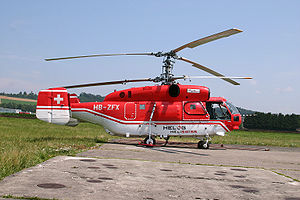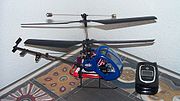
Coaxial rotor
Encyclopedia

Helicopter rotor
A helicopter main rotor or rotor system is a type of fan that is used to generate both the aerodynamic lift force that supports the weight of the helicopter, and thrust which counteracts aerodynamic drag in forward flight...
s mounted one above the other on concentric shafts, with the same axis of rotation, but that turn in opposite directions (contra-rotation). This configuration is a feature of helicopters produced by the Russia
Russia
Russia or , officially known as both Russia and the Russian Federation , is a country in northern Eurasia. It is a federal semi-presidential republic, comprising 83 federal subjects...
n Kamov
Kamov
Kamov is a Russian rotor-winged aircraft manufacturing company that was founded by Nikolai Il'yich Kamov, who started building his first rotor-winged aircraft in 1929, together with N. K. Skrzhinskii...
helicopter design bureau.
Angular momentum
One of the problems with any single set of rotor blades is the tendency of the helicopterHelicopter
A helicopter is a type of rotorcraft in which lift and thrust are supplied by one or more engine-driven rotors. This allows the helicopter to take off and land vertically, to hover, and to fly forwards, backwards, and laterally...
body to begin spinning in the opposite direction to that of the rotors once airborne. This is due to the principle of conservation of angular momentum
Angular momentum
In physics, angular momentum, moment of momentum, or rotational momentum is a conserved vector quantity that can be used to describe the overall state of a physical system...
: The engines of the helicopter, by exerting torque
Torque
Torque, moment or moment of force , is the tendency of a force to rotate an object about an axis, fulcrum, or pivot. Just as a force is a push or a pull, a torque can be thought of as a twist....
on the rotor blades, give a sizable amount of angular momentum to the blades. Absent external forces such as contact with the ground, the angular momentum of the blades must be offset by a change in angular momentum of the body for momentum to be conserved. While the engine spins up the blades, the blades apply equal yet opposite torque to the body, causing the body to gain spin angular momentum in the other direction. This phenomenon would cause the helicopter to lose control if not checked. To counteract the effect, the tail rotor
Tail rotor
The tail rotor, or anti-torque rotor, is a smaller rotor mounted so that it rotates vertically or near-vertically at the end of the tail of a traditional single-rotor helicopter. The tail rotor's position and distance from the center of gravity allow it to develop thrust in the same direction as...
was introduced to provide a constant input of angular momentum to the body opposite in direction to that from the main rotor. Then, the helicopter's fuselage remains stationary and stable level flight becomes possible. Varying the torque exerted by the tail rotor on the body of the helicopter (hence changing the magnitude of the angular momentum input) facilitates controlled turning. This gives the helicopter extreme maneuverability, and the helicopter can hover and pivot about the rotor axis. Control of rotational motion with designs lacking tail rotors is achieved by using two sets of rotor blades rotating in opposite directions, canceling each other's angular momentum.
Coaxial rotors solve the problem of angular momentum by turning each set of rotors in opposite directions. The equal and opposite torques from the rotors upon the body cancel out. Rotational maneuvering, yaw control, is accomplished by increasing the collective pitch of one rotor and decreasing the collective pitch on the other. This causes a controlled dissymmetry of torque.
Dissymmetry of lift
Dissymmetry of lift is an aerodynamic phenomenon that is caused by the rotation of a helicopter's rotors in forward flight. Rotor blades provide lift proportional to the amount of air flowing over them. When viewed from above, the rotor blades move in the direction of flight for half of the rotation (advancing half), and then move in the opposite direction for the remainder of the rotation (retreating half). During the advancing half, a rotor blade produces more lift. As a blade moves toward the direction of flight, the forward motion of the aircraft increases the speed of the air flowing around the blade until it reaches a maximum, when the blade is perpendicular to the relative windRelative wind
In aeronautics, the relative wind is the direction of movement of the atmosphere relative to an aircraft or an airfoil. It is opposite to the direction of movement of the aircraft or airfoil relative to the atmosphere...
. At the same time, a rotor blade in the retreating half produces less lift. As a blade moves away from the direction of flight, the speed of the airflow over the rotor blade is reduced by an amount equal to the forward speed of the aircraft, reaching its maximum effect when the rotor blade is again perpendicular to the relative wind. Coaxial rotors reduce the effects of dissymmetry of lift through the use of two rotors turning in opposite directions, causing blades to advance on either side at the same time.
Other benefits
One other benefit arising from a coaxial design include increased payload for the same engine power — a tail rotor typically wastes some of the power that would otherwise be devoted to lift and thrust, whereas with a coaxial rotor design, all of the available engine power is devoted to lift and thrust. Reduced noise is a second advantage of the configuration — part of the loud 'slapping' noise associated with conventional helicopters arises from interaction between the airflows from the main and tail rotors, which in some designs can be severe. Also, helicopters using coaxial rotors tend to be more compact (occupying a smaller 'footprint' on the ground), though at the price of increased height, and consequently have uses in areas where space is at a premium — several Kamov designs are used in navalNavy
A navy is the branch of a nation's armed forces principally designated for naval and amphibious warfare; namely, lake- or ocean-borne combat operations and related functions...
roles, being capable of operating from confined spaces on the decks of ships, including ships other than aircraft carrier
Aircraft carrier
An aircraft carrier is a warship designed with a primary mission of deploying and recovering aircraft, acting as a seagoing airbase. Aircraft carriers thus allow a naval force to project air power worldwide without having to depend on local bases for staging aircraft operations...
s (an example being the Kara Class cruisers
Kara class cruiser
The Kara is a class of Cold War era Soviet guided missile cruisers. The Soviet designation is Project 1134B Berkut B - Беркут Б and the Soviet mission description is "large anti-submarine warfare ship" and not "cruiser".-Design:...
of the Russian navy, which carry a Ka-25
Kamov Ka-25
|-See also:-Bibliography:* Gunston, Bill. “The Osprey Encyclopaedia of Russian Aircraft 1875–1995”. London, Osprey. 1995. ISBN 1 85532 405 9-External links:* http://www.aviation.ru/Ka/#25* http://www.aviastar.org/helicopters_eng/ka-25.php...
'Hormone' helicopter as part of their standard fitment). Another benefit is increased safety on the ground; by eliminating the tail rotor, the major source of injuries and fatalities to ground crews and bystanders is eliminated.
Disadvantages
A principal disadvantage of the coaxial rotor design is the increased mechanical complexity of the rotor hub. The linkages and swashplatesSwashplate (helicopter)
A swashplate is a device that translates input via the helicopter flight controls into motion of the main rotor blades. Because the main rotor blades are spinning, the swashplate is used to transmit three of the pilot's commands from the non-rotating fuselage to the rotating rotor hub and...
for two rotor systems need to be assembled atop the mast, which is more complex because of the need to drive two rotors in opposite directions. Because of the greater number of moving parts and complexity, the coaxial rotor system is more prone to mechanical faults and possible failure. However, US Army experience from the Vietnam War indicates that damage to the tail rotor and the long driving shaft, from enemy fire or treetop collisions, was the most frequent cause of helicopter losses, so from a military viewpoint the issue may be more complex. Also Kamov maintains that its coaxial assembly is built to withstand direct hits from 20 mm cannon fire and presents a small target. Kamov does have a good mechanical reliability record from use in demanding conditions including offshore oil rigs and Russian Navy vessels.
Coaxial models

Cyclic/collective pitch mixing
Used in radio-controlled helicopters, Cyclic/collective pitch mixing reduces mechanical complexity and increases precision of control of the helicopter rotor's swashplate.- Conventional operation :...
model.
While such a model is extremely stable and can be flown indoors even in tight quarters, a coaxial model helicopter has limited forward speed, especially outdoors. Most such models are fixed-pitch (i.e., the blades do not rotate on their axes), which simplifies the model, but eliminates the ability to compensate with collective input. Compensating for even the slightest breeze causes the model to climb rather than to fly forward even with full application of cyclic.
Hazards of helicopter flight
The U.S. Department of Transportation has published a “Basic Helicopter Handbook”. One of the chapters in it is titled, “Some Hazards of Helicopter Flight'. Ten hazards have been listed to indicate what a typical single rotor helicopter has to deal with. The unique coaxial rotor design either reduces or completely eliminates these hazards. The following list indicates which:- Settling with power — Reduced
- Retreating blade stall — Reduced
- Medium frequency vibrations — Reduced
- High frequency vibrations — None
- Anti torque system failure in forward flight — Eliminated
- Anti torque system failure while hovering — Eliminated
The reduction and elimination of these hazards are the strong points for the safety of coaxial rotor design.
List of co-axial rotor helicopters
- Breguet-Dorand giroplane laboratoire (1936)Gyroplane Laboratoire-External links:* -See also:...
- Breguet GIIE (1949-1951)
- Cierva CR TwinCierva CR Twin-External links:*http://www.aviastar.org/helicopters_eng/cierva_grasshopper.php...
- Gyrodyne QH-50
- Kamov Ka-15Kamov Ka-15-See also:-References:* Gunston, Bill. The Osprey Encyclopedia of Russian Aircraft 1875–1995. London:Osprey, 1995. ISBN 1 85532 405 9.* Stroud, John. Soviet Transport Aircraft since 1945. London:Putnam, 1968. ISBN 0 370 00126 5.-External links:...
- Kamov Ka-25Kamov Ka-25|-See also:-Bibliography:* Gunston, Bill. “The Osprey Encyclopaedia of Russian Aircraft 1875–1995”. London, Osprey. 1995. ISBN 1 85532 405 9-External links:* http://www.aviation.ru/Ka/#25* http://www.aviastar.org/helicopters_eng/ka-25.php...
- Kamov Ka-26
- Kamov Ka-226Kamov Ka-226|- See also :- External links :* http://www.aviation.ru/Ka/#226* * http://www.aviastar.org/helicopters_eng/ka-226.php* http://www.aerospace-technology.com/projects/ka226/...
- Kamov Ka-27Kamov Ka-27|-See also:-External links:*...
- Kamov Ka-32
- Kamov Ka-50Kamov Ka-50The Kamov Ka-50 "Black Shark" is a single-seat Russian attack helicopter with the distinctive coaxial rotor system of the Kamov design bureau. It was designed in the 1980s and adopted for service in the Russian army in 1995...
Black Shark - Kamov Ka-52
- Manzolini LibellulaManzolini Libellula- External links :* at aviastar.org* * http://www.webcitation.org/query?url=http://www.geocities.com/CapeCanaveral/Launchpad/5249/manzolini.htm&date=2009-10-25+15:56:04-See also:...
- Sikorsky S-69Sikorsky S-69-See also:-External links:* * * *...
- Sikorsky X2Sikorsky X2The Sikorsky X2 is an experimental compound helicopter with coaxial rotors developed by the American aircraft manufacturer Sikorsky Aircraft. It is considered to be the fastest helicopter ever produced.-Design and development:...
- Kamov-Kumertau Rotorfly
- Kamov Ka-31Kamov Ka-31|-See also:-External links:* *...

